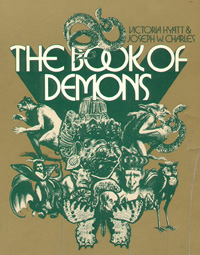The Introduction
 An
Excerpt on Demons
An
Excerpt on Demons
On a not too distant horizon looms a new millennium. Just as the end of the tenth century was a time of crisis and anxiety, so is the end of the twentieth century a deeply troubled era. The consciousness of mankind is in an uproar of an intensity perhaps never experienced in the history of this race. All our habits, beliefs and endeavors are coming in for some very sharp and necessary rethinking. Taking science as an example, the more minutely some phenomena are examined.
The more the universe seems a deterministic, closed system. The modern scientist, or the scientist brought up in the tradition of "objective scientific investigation" as laid down by the great minds of the last few centuries, examines phenomena selectively in order to see them more clearly. To justify this act of isolation or amputation, he invented a philosophy and a methodology that is mechanical and reductive. This does not allow him to see the interrelation of all things. He squints when all that is necessary is that he opens his eyes. This is because science has abandoned the idea that everything is dependent on everything else, and replaced it with the notion that one thing causes another in a rigorously determined and determinable way. This blinkered attempt can be likened to bicycling the wrong way up a col-de-sac.
And so demons; demons? The idea is patently absurd in our "scientific" age. Of course it is absurd to a mentality that excludes possibilities to justify itself.
But as soon as we are able to see again in a total way, or when we comprehend the universe as a space and time continuum where everything is connected, the idea of demons will cease to be ridiculous. There are forces around us that we cannot perceive with our normal senses, just as we cannot perceive certain light frequencies that lie beyond the scope of our physical eye. But today nobody doubts the existence of infrared or ultra-violet frequencies any more. If modern science can accept the fact that various kinds of phenomena can exist simultaneously in the same place, how can it a priori deny that different levels of being can exist under the same conditions?
There is nothing that will conclusively disprove the existence of the spirit world, but there are many things that point toward the very fact of its actual existence.
The recent renewal of interest in the occult sciences is not a mere fad, as some would have it. It is a genuine attempt to find ways of thinking about the world and the universe that might free us from the straight-jacket we are caught in at these crucial crossroads where time, a new era, a new millennium and the new frontiers of space meet.
The present book (the Book of Demons, by Charles/Hyatt whose introduction this is), which deals with a very limited number of evil spirits from a large number of vastly differing cultures and civilizations, has at its core the honest wish to reopen forgotten areas of speculation that the authors deem of great importance.
To put it in the words of the American writer and poet, Robert Kelly: "The traditional sciences, which can by our social forms be made superstitious holdovers, represent at best that empirical speculativeness which constitutes our best mind - study thereof can make us perceptive of conditions, states, rhythms we are no longer in our bodies conscious of. For the New Yorker, the stars are for the most part hearsay (which can be " superstitious holdover "), like the rings of Saturn to an eye without a telescope, like the virus to a man without an electron micro- scope. There are no ready pragmatic ways of inferring the Pleiades. They go unseen, their dance ignored. And we are cut off".